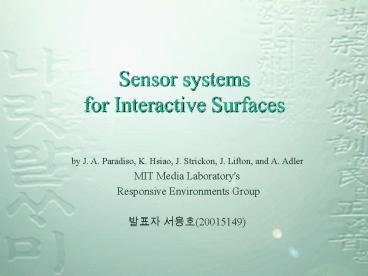Sensor systems for Interactive Surfaces PowerPoint PPT Presentation
1 / 13
Title: Sensor systems for Interactive Surfaces
1
Sensor systems for Interactive Surfaces
- by J. A. Paradiso, K. Hsiao, J. Strickon, J.
Lifton, and A. Adler - MIT Media Laboratory's
- Responsive Environments Group
- ??? ???(20015149)
2
Contents
- Intro
- Approaches to smart walls
- An inexpensive scanning laser rangefinder
- Acoustic tap tracking
- Sensate floors
- Resonant tags
- Conclusions and future developments
3
Intro
- Recent work by the MIT Media Laboratory's
Responsive Environments Group - new user interface devices for interactive
surfaces and large-scale public installations - four different systems that we have developed for
capturing various manners of gesture near
interactive surfaces - An inexpensive scanning laser rangefinder
- Acoustic tap tracking
- Sensate floors
- Resonant tags
- we describe the technology and demonstration
applications behind four systems
4
Approaches to smart walls
- Most of the commercial products at the digitizing
tablet and smart whiteboard markets require
contact or pressure to be applied against a
sensitive surface - to very large displays becomes complicated and
expensive with existing technologies - Some smart wall hand-tracking systems
- an array of IR LEDs across the top of the display
and two linear CCD arrays at the corners - using computer vision
- can be expensive, illumination difficulties!
5
- the Gesture Wall by Media Lab
- used transmit-mode capacitive sensing
- injected a 50100 kHz signal into the body of the
user through an electrode on the floor - The strengths of this signal, as capacitively
received at electrodes placed in the four corners
of the display
6
An inexpensive scanning laser rangefinder
- a scanning laser rangefinder at one corner of the
display to determine the polar (r, ?) coordinates
of hands in a plane above the projection surface - laser rangefinders are commercially available
devices, used for survey, robotic, and military
applications. But still considerably expensive - Triangulation rangefinders, with a displaced
source and imaging receiver can provide very high
depth resolution over a limited dynamic
range(used in 3-D object scanning)
7
- The actual working scan head and diagram of
laserfinder
The basebanded signals produced by scanner for a
pair of hands and rangefinder performance
8
Rangefinder performance and applications
- The parts cost of this device is well under 500
!!! - a point-to-point noise resolution (standard
deviation) of roughly 1.4 cm across the 6x8
foot screen after calibration
9
Acoustic tap tracking
- The most direct method of clicking, however,
would be to just tap the screen - The impact position on a table was determined in
real time through differential time between the
signals recorded by four microphones(PingPongPlus
installation case) - Using contact pickups made of polyvinylidene
fluoride (PVDF) piezoelectric foil for locating
the positions of fingers knocking on screen
10
Sensate floors
- A grid of shielded cable, similar to standard
coaxial wire but with a piezoelectric copolymer
used for the inner insulation, is placed on the
floor(spaced at a 4-inch pitch) - The piezoelectric material produces a voltage (in
the 15 volt range if terminated with a high
impedance) when the wire is stepped
o(proportional to foot pressure) - Our current setup uses a grid of 16 32 wires at
a 4-inch pitch below a 6 10 foot trapezoidal
segment of carpet
11
Resonant tags
- To explore responsive-surface applications
- developing a simple, swept-frequency resonant tag
reader(a simple inductive bridge, with excitation
swept between roughly 50 kHz300 kHz,
30times/sec) - When a magnetically coupled resonance (LC tag)
approaches the reader, it draws energy and
producing a blip and digitized by an onboard micom
12
Resonant tags
13
Conclusions and future developments
- Several different techniques for making surfaces
interactive and opening up new modes of
computer-user interaction for responsive
environments - The application examples described in this paper
are multimedia in nature(surface walls, floors,
windows, etc...) - Exploring new techniques for 3-D tracking
- the multi-axis position of our resonant tags
accurately across desktop-sized 3-D spaces for
new user interface and medical applications

